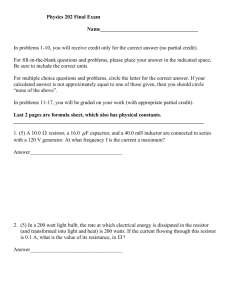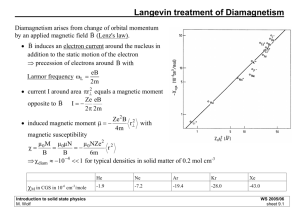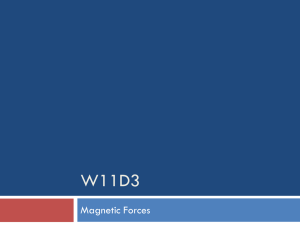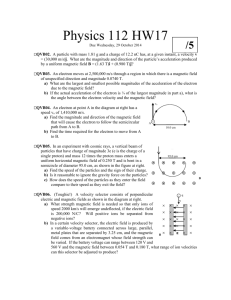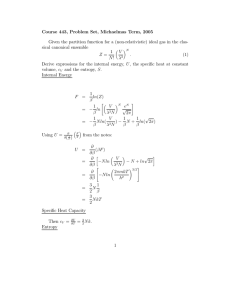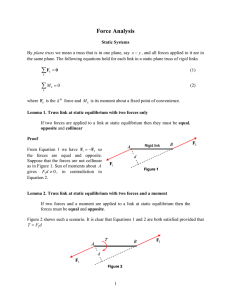AP Physics – Electro/Magnetic - 10 Fy Fx F
advertisement
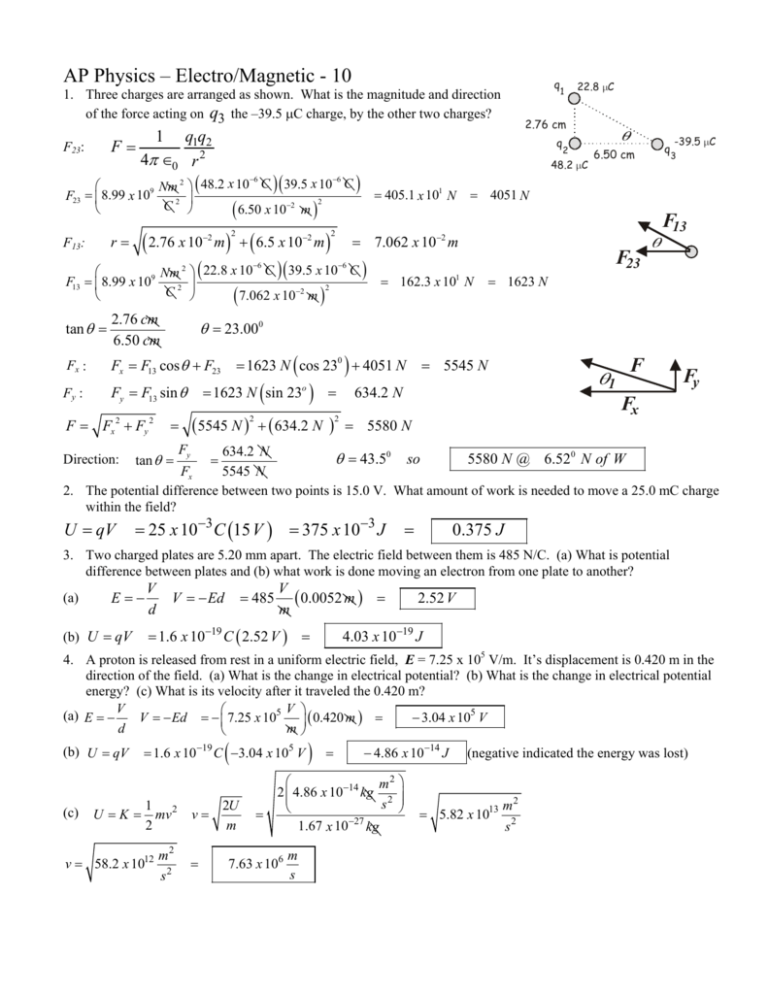
AP Physics – Electro/Magnetic - 10 q 1. Three charges are arranged as shown. What is the magnitude and direction of the force acting on q3 the –39.5 C charge, by the other two charges? q 2.76 x 10 m 6.5 x 10 m r F13: 2 2 405.1 x 101 N 2.76 cm 6.50 cm Fx : Fx F13 cos F23 Fy : Fy F13 sin F Fx Fy 2 q -39.5 mC 3 4051 N F13 2 7.062 x 10 m 2 22.8 x 10 6 C 39.5 x 106 C 9 Nm F13 8.99 x 10 2 C2 7.062 x 102 m tan 6.50 cm 6 2 2 2 48.2 mC Nm 48.2 x 10 C 39.5 x 10 C F23 8.99 x 109 2 C2 6.50 x 102 m 6 2 22.8 mC 2.76 cm 1 q1q2 F 4 0 r 2 F23: 1 F23 162.3 x 10 N 1 1623 N 23.000 2 1623 N cos 230 4051 N 1623 N sin 23 o 5545 N 634.2 N 2 Fy 2 5545 N F 1 634.2 N Fy Fx 5580 N 634.2 N 43.50 so 5580 N @ 6.520 N of W 5545 N Fx 2. The potential difference between two points is 15.0 V. What amount of work is needed to move a 25.0 mC charge within the field? 3 3 Direction: tan U qV 25 x 10 C 15 V 375 x 10 J 0.375 J 3. Two charged plates are 5.20 mm apart. The electric field between them is 485 N/C. (a) What is potential difference between plates and (b) what work is done moving an electron from one plate to another? (a) E (b) U qV V d V Ed 485 V 0.0052 m m 1.6 x 1019 C 2.52 V 2.52 V 4.03 x 1019 J 4. A proton is released from rest in a uniform electric field, E = 7.25 x 105 V/m. It’s displacement is 0.420 m in the direction of the field. (a) What is the change in electrical potential? (b) What is the change in electrical potential energy? (c) What is its velocity after it traveled the 0.420 m? V V (a) E V Ed 7.25 x 105 0.420 m 3.04 x 105 V d m (b) U qV (c) U K 1.6 x 1019 C 3.04 x 105 V 1 2 mv 2 v 58.2 x 1012 m2 s 2 v 2U m 4.86 x 10 14 J m2 2 4.86 x 1014 kg 2 s 27 1.67 x 10 kg 7.63 x 106 m s (negative indicated the energy was lost) 5.82 x 1013 m2 s2 5. 7.45 x 1018 electrons take 0.52 seconds to flow through a 75 resistor in a circuit. (a) What is the current? (b) What is the voltage drop across the resistor? (c) What is the power consumed by the resistor? (a) (b) 7.45 x 10 e 1.6 x 1019 C 1 2.3 A 22.9 x 10 A 0.52 s e 1 V IR 2.3 A 75 170 V (c) P IV 2.3 A 170 V q I t 18 390 W 6. Two charges are arranged as shown. (a) find the electric potential at P. (b) how much work would it take to bring in a charge of 48.0 C from infinity to point P? q (a) 1 V 4 0 3.38 x 10 r1 Need r1: 1 1 q1 q2 V 4 0 r1 r2 q i ri i 2 2 2 6 15.5 x 10 6 C C 9 Nm 345 x 10 V 8.99 x 10 1.25 x 10 2 m C 2 3.604 x 10 2 m V 8.99 x 109 V 95.73 x 10 4 12.4 x 10 4 V (b) 33.8 mm m 1.25 x 102 m 3.604 x 102 m 2 345 mC q 2 -15.5 mC 8.99 x 109 V 83.33 x 10 4 P 12.5 mm 749 x 105 V 7.49 x 10 7 V 48 x 106 C 7.49 x 107V U qV 360 x 101 J 3.60 x 103 J 7. Two wires run parallel to each other. They are both 12.0 cm in length. They are separated by 3.65 cm. The wire on the left is carrying a current of 2.50 A and the wire on the right is carrying a current of 1.85 A. The currents have opposite directions. What is the force that is acting between them? F 0 I1 I 2l 2 d T m 2.5 A 1.85 A 0.12 m 4 x 107 A 2 0.0365 m 30.4 x 107 N 3.04 x 106 N 8. A hot plate is in a parallel circuit with a voltage drop of 120 V (household AC electricity). The current in the circuit is 5.8 A (a) What is the resistance of the hot plate? (b) How much power did it develop? (c) If it operated for 18 minutes, how much heat did it develop? (d) If a kWh costs 5.6 cents, how much did it cost to run the thing for the 18 minutes? (a) V IR (b) P IV (c) P W t (d) W Pt R V I 120 V 5.8 A 5.8 A 120 V W Pt 7.0 x 102 21 7.0 x 102 W 60 s J 2 18 min 7600 x 10 J s 1 min 1h 5.6 cents 0.70 kW 18 min 0.21 kWh 60 min 1 kWh 7.6 x 105 J 1.2 cents 9. Examine this useless circuit. What is: (a) the total resistance, ( b) the total current, (c) the terminal voltage of the battery? The voltage drop across R1 is 9.00 V. (a) 1 1 1 R234 R2 R3 R4 R R1 R234 (b) V IR (c) V IR 1 1 75 38 15 45 31.1 I V R V1 R1 9V 45 0.200 A 76 R234 31.1 45.0 W R2 76.1 0.200 A R4 15.2 V 75.0 W R1 V 9.00 V R3 38.0 W 15.0 W 10. What is the magnetic field 2.50 cm from a straight wire carrying a current of 0.858 A? If the current is from left to right, what is the direction of the magnetic field? 0 I 2 r T m 0.858 A 4 x 107 A 2 0.025 m (a) B (b) Out of paper at top, into paper at bottom. 68.6 x 107 T 6.86 x 106 T 11. An electron enters a magnetic field (2.35 x 103 T) as shown. The electron’s kinetic energy is 2.56 x 10-15 J. (a) draw in a likely path for the electron to follow when it enters the magnetic field. (b) What is the magnetic force acting on the electron in the field? (c) What is the radius of the electron’s path in the magnetic field? (b) K 1 2 mv 2 v 2K m m2 15 2 2.56 x 10 kg 2 s 9.11 x 1031 kg 7.50 x 107 m s m F qvB 1.6 x 1019 C 7.50 x 107 2.35 x 103 T 2.82 x 108 N s m 9.11 x 1031 kg 7.50 x 107 2 mv mv s r 18.2 x 108 m (c) qvB 19 3 r qB 1.6 x 10 C 2.35 x 10 T 2 12. A rectangular loop enters a magnetic field of 1.25 x 10 T. It is moving at a constant speed. The induced emf when it enters the field is 24.5 V. What is the velocity of the cart? v 1.82 x 107 m 5.00 cm 3.00 cm v 15.0 cm Blv v Bl 24.5 V 1.25 x 10 T 0.030 m 2 653 x 102 m s 6.53 m s 13. A metal rod is pulled into a magnetic field, B = 60.6 T, at a constant velocity of 12.5 m/s while it is in contact with two conducting rails. The rails are separated by a distance of 7.50 cm. A resistor has been placed between the rails at the edge of the field as shown. The current through the resistor is 1.25 A. Find (a) the emf induced into the rod by its motion through the field. (b) The resistance of R, the resistor between the rails. (c) The direction of the current through R. (d) The Force, Fa, applied to the rod to make it move through the magnetic field (a) Blv 60.6 T 0.075 m 12.5 (b) V IR R V I 56.8 V 1.25 A m s 56.8 V 45.4 (c) Up through R, so CW (d) Fm Fa BIl 60.6 T 1.25 A 0.075 m 5.68 N R v Fa
